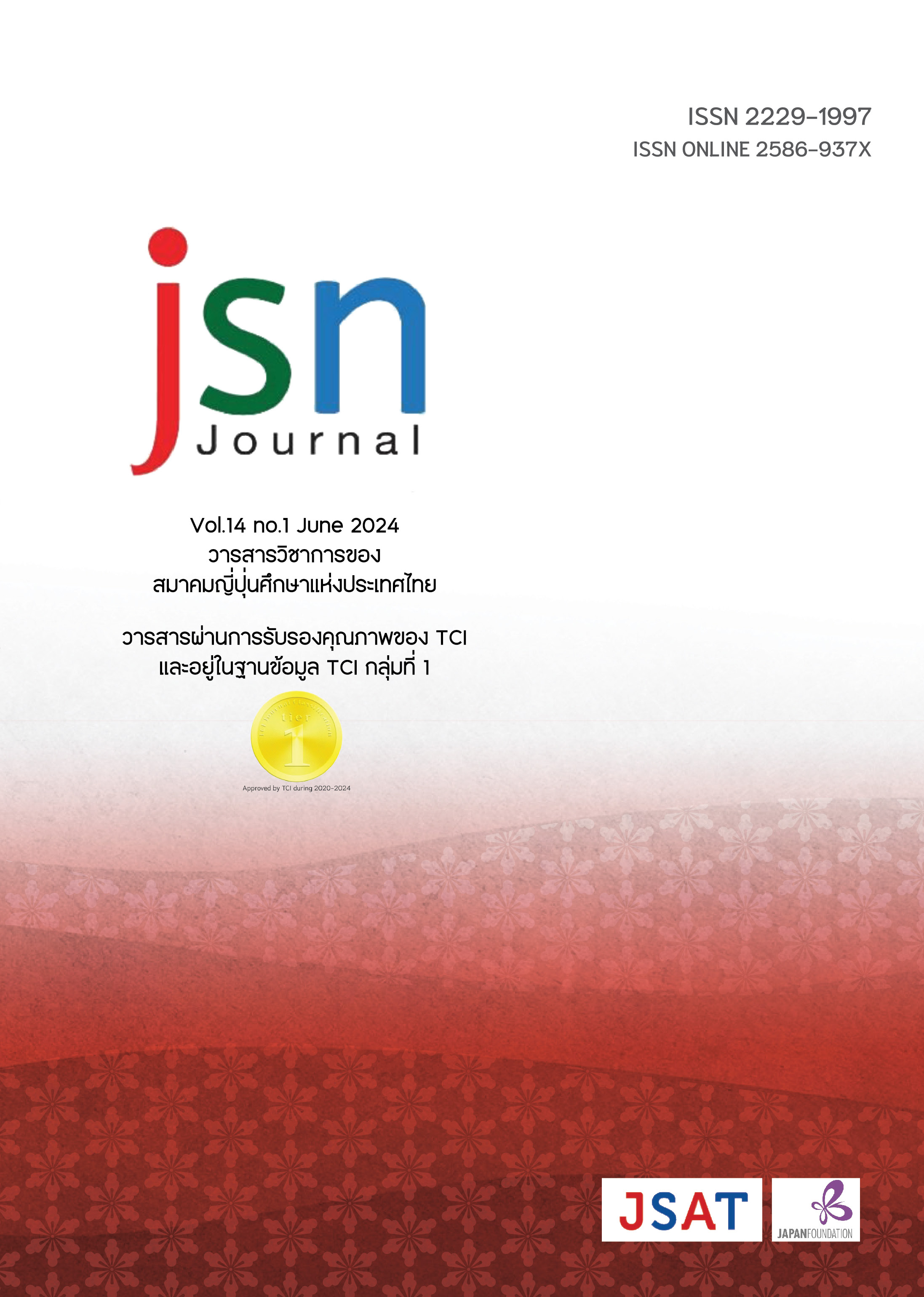Students’ Opinions toward the Use of News Clips from a Japanese News YouTube Channel in Consecutive Interpreting Practice from Japanese into Thai
Main Article Content
Abstract
The objective of this research was to survey Thai undergraduate students' opinions toward the use of news clips in consecutive interpreting practice, the appropriateness and expectations of the method and procedures of practicing as well as their opinions toward problems during consecutive interpreting practice into Thai. Results revealed that: 1. Students had a positive attitude toward the use of news clips to practice consecutive interpreting into Thai. Students strongly agreed that using news clips would help them learn new vocabulary and that using news clips in interpreting practice is a difficult challenge. 2. Overall, students had a positive attitude toward the method and procedures that the instructor used. Students strongly agreed with the use of news clips in which the news anchors and reporters speak at the native Japanese speaking speed and with the way the instructor allowed students to see a list of difficult or specific terms, or proper nouns during practicing. Also, students strongly agreed with the use of audio clips instead of video clips because watching videos distract them from listening and note-taking. In terms of their expectations, students highly expected that the instructor would provide quick responses for difficult or specific terms, or proper nouns before the practice. 3. Regarding the problems during practicing, students strongly agreed that there were two problems, one being able to understand the content but having a difficulty memorizing the content and the other being able to understand and memorize the content but unable to come up with appropriate translation in time.
Article Details

This work is licensed under a Creative Commons Attribution-NonCommercial-NoDerivatives 4.0 International License.
ข้อความและข้อคิดเห็นต่างๆ ในบทความเป็นของผู้เขียนบทความนั้นๆ ไม่ใช่ความเห็นของกองบรรณาธิการหรือของวารสาร jsn Journal
References
ธารทิพย์ แก้วทิพย์. (2545). การแปลแบบล่าม : แนวคิดเชิงทฤษฎีและวิธีปฏิบัติ. วารสารศิลปศาสตร์ มหาวิทยาลัยธรรมศาสตร์, 2(1), 26-42
บุญชม ศรีสะอาด. (2539). การแปลผลเมื่อใช้เครื่องมือรวบรวมข้อมูลแบบมาตราส่วนการประมาณค่า. วารสารการวัดผล การศึกษามหาวิทยาลัยมหาสารคาม, 2(1), 64-70
บุญชู ตันติรัตนสุนทร. (2552). ล่ามอาชีพ. กรุงเทพฯ: บ้านพระอาทิตย์.
บุษบา บรรจงมณี. (2547). รายงานการศึกษาความต้องการใช้งานล่ามภาษาญี่ปุ่น-ไทย และแนวทางพัฒนาการสอนวิชาการ แปลแบบล่าม. วารสารมนุษยศาสตร์, 12, 12-26.
พัฒนา พรหมณี, ยุพิน พิทยาวัฒนชัย, และ จีระศักดิ์ ทัพผา. (2563). แนวคิดเกี่ยวกับความพึงพอใจและการสร้างแบบสอบถามความพีงพอใจในงาน. วารสารวิชาการสมาคมสถาบันอุดมศึกษาเอกชนแห่งประเทศไทย (สสอท.), 26(1), 59-66.
วรรรณิดา ยืนยงค์ และ สมเกียรติ เชวงกิจวณิช. (2562). บทบาทหน้าที่ของล่ามและปัญหาการล่ามภาษาญี่ปุ่นชาวไทยในโรงงานอุตสาหกรรมของประเทศไทย กรณีศึกษาความแตกต่างระหว่างล่ามมือใหม่ และ ล่ามมืออาชีพ. เอกสารหลังการประชุมวิชาการบัณฑิตศึกษาระดับชาติ สรรพศาสตร์ สรรพศิลป์ ประจำปี 2562, 441-461.
วราลี จันทโร และ ธนภัส สนธิรักษ์. (2563). การวิเคราะห์ปัญหาด้านการใช้ภาษาญี่ปุ่นที่พบในการฝึกงาน: กรณีศึกษาผู้เรียนวิชาเอกภาษาญี่ปุ่น. วารสารเครือข่ายญี่ปุ่นศึกษา, 10(1), 65–82.
Benny Lewis. (2023). The benefits of using the news to learn a foreign language. Higher education discovery, https://hedclub.com/en/library/the_benefits_of_using_the_news_to_learn_a_foreign_language สืบค้นวันที่ 25 ธันวาคม 2566
飯塚秀樹(2009).「通訳訓練法による英語力向上の有意性と語学指導への応用ー最新のSLA研究の視座 を交えてー」『通訳翻訳研究』9, 107-122.
稲生衣代・河原清志・溝口良子・中村幸子・西村友美・関口智子・新崎隆子・田中深雪(2010).「日本における通訳教育の課題と展望」『日本通訳翻訳学会・通訳教育分科会』, 259-278.
熊谷ユリヤ(2016).「様々なレベルの通訳コースにおける同時通訳の導入と訓練」『札幌大学総合論 叢』41, 17-33.
椎名紀久子・楊昉(2001).「テレビニュースを活用した日本語CALL教材の開発」『言語文化論叢』9, 23-38.
染谷泰正 (1995).「日本における通訳者訓練の問題点と通訳訓練に必要な語学力の基準」『通訳理論研 究10』6(1), 46-58.
田中郁子・柳澤理子 (2013).「外国人医療通訳者の体験した困難とその対処」『国際保健医療』28(4), 305-316.
田中深雪 (2004).「『通訳訓練法』を利用した大学での英語教育の実際と問題点」『通訳研究』4, 63-82.
中野真規子(2004).「ニュース教材を利用した聴解実践研究」『日本語実践研究』1, 181-188.
中村美咲(1994).「読解教材としての新聞記事の可能性」『徳山大学論叢』58, 73-84.
林正雄 (2001).「ワールド・ニュースを用いたマルチメディア教材研究」『静岡大学教育学部研究報告 (人文・社会科学編』51, 151-162.
山田一郎・住吉英樹・柴田正啓 (2002).「ニュース記事に出現する用語と説明文の意味関係自動獲得」『自然言語処理』, 145-152.
渡辺薫 (2018).「動画サイトニュースを使った授業の再考ーニュースで学ぶ選択科目授業の実践報告 ー」『ハンガリー日本語教育シンポジウム』, 1-6.


